A Look at Different Types of Roofing Materials

The roof style is essential because it contributes to building aesthetics, and the style depends on the choice of roofing material and its design!

Photo By: John Lively & Associates
The choice of roofing material determines the longevity of roofs, and the installing technique differs according to the type of roofing material. The kind of building determines the type of roofing material that it needs. Flat roofs will need roofing materials that are different from those meant for sloped roofs. For instance, using a membrane for waterproofing a flat roof is essential to protect against water damage and ensure durability of the structure. Similarly, the roofs of commercial buildings are different from residential roofs, both in the quality of construction and the choice of roofing material. Regardless of the decision of roofing material, it must have the ability to provide protection from the elements of weather and last long enough in accordance with the designated roof life.
The building type, whether it is commercial or residential, influences the choice of roofing materials. Knowing how the materials differ from another in its construction and application and understanding the differences between commercial and residential with respect to design and roofing material will help to choose the right type of roofing.
Roof Design
Commercial roofing systems are much larger than residential roofing systems because the building sizes are much larger. Commercial roofs can be either flat or sloped depending on the type of building, and the latter is most prevalent for sheds, warehouses, and industrial structures. Sloped roofs require almost no maintenance, and the factors to consider when designing commercial roofing systems are the load that the roof must bear, especially the weight of snow in cold regions, as well as the weight of equipment that it must carry. For residential roofs, there is no need to consider the structural in so many details.
Roofing Materials
Just as the structural requirements are different for commercial and residential buildings, so also are the roofing materials. The choice of which depends on the type of application, as well as longevity and cost. Commercial roofs are generally flat, and metal or membrane roofing is the usual choice, whereas the options are much more for residential buildings.
For installing any roof, whether commercial or residential, you must engage a roofing company like Patriot Roofing and Construction Salt Lake City to ensure satisfactory installation after choosing the right roofing material. Here are some commercial roofing materials that you will generally come across.
SPF Roofing
Known as SPF roofing, it is Spray Polyurethane Foam roofing that is popular for commercial roofing systems. The eco-friendly material came in liquid form and sprayed on the roof surface, after which it expands and solidifies to form a thick layer on the roof surface. Despite being in use for more than 50 years, the technology is yet much popular. Depending on the quality of installation, SPF roofs can last for 50 years and is suitable for all kinds of climate.
SPF enhances the energy efficiency of buildings and creates an excellent barrier for moisture, thermal, and air besides having good water-resistant quality. Long life and environment friendliness make SPF a good choice.
Membrane Roofing, Single-ply (EPDM Roofing)
Single ply membrane roofing has been in use for commercial buildings for quite a long time. SPF is one of the most popular commercial roofing materials that are available in a wide price range that suits every budget. The roofing consists of fastening sheets of rubber or other synthetic materials to the insulation material by using the technique of ballasting or chemical bonding. It helps to create a protective layer on the roof. It is Class A fire-rated, and the white reflective color of TPO membranes improves the quality of insulation of the building. Since the membrane roofing material does not include the insulation factor, users have more options to decide about the type of insulation to use.
Shingles Roofing
Considered one of the most versatile roofing materials, shingles roofing has enjoyed immense popularity for residential buildings and even the right choice for commercial buildings. Sloping roofs can have asphalt shingles as well as wood shingles and those made from plastic, ceramic, metal, and slate, but finally, it boils down to architectural shingles and asphalt shingles. The latter is most popular because it is highly affordable that suits all kinds of budget and comes with full warranty options ranging between 15 and 30 years.
Architectural shingles are multi-layered that makes the material stronger, and it is weatherproof and more durable. The easy to install roofing material is also easy to repair and comes with extended warranties that often last a lifetime. It comes in a variety of styles, designs, and colors.
Metal Roofing
Metals have been the oldest commercial roofing material that still maintains its popularity. Corrugated galvanized sheets that have high strength and durability are the most used metal roofing material, and aluminum roofing is a choice too. Metal roofs are fire-resistant and lightweight and easy to install on the existing roof besides being waterproof and UV resistant as well as rustproof. Adding a protective coating with enhancing the roof life. Metal roofs are available in many colors and stable enough to withstand heavy snow and high winds.
Built-up Roofing
Built-up roofing systems have been in use for about a hundred years, and people usually know it as tar and gravel roofing. When laying the roof, the contractor will install into the roof directly alternate layers of asphalt or tar along with felt or similar supporting fabric. To create the most robust roofing, you must ensure that it has 5 layers of the roofing material, and for a lighter roof, 3 layers are good enough. A layer of stone or gravel at the top of the roofing material provides a protective surface that also ensures UV protection. The roof has a seamless surface as there are no joints, and it reduces the chances of leakage. This low-cost roofing system needs low maintenance, which further increases its attraction.
The nature of the building and its use determine the type of roof that would be suitable, which can meet the needs. Once you know the requirements, it becomes easy to choose the roofing material.









Leave a Comment